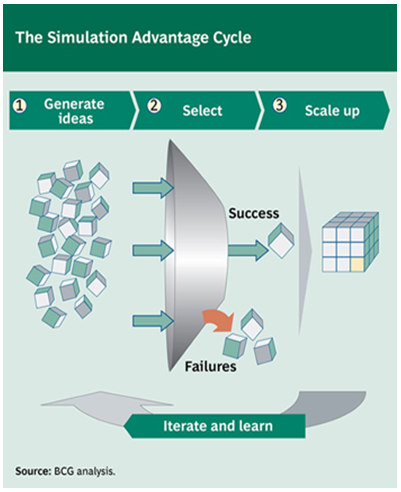
Experimentation is used to develop and test new products and services by companies all over the world. There are many challenges in applying traditional approaches to experimentation. Cost and time constraints can saddle the organization with an unreasonable burden of complexity. Market-facing tests and pilots can jeopardize a company’s brand and reputation.
To get rid of these problems, a increasing number of companies are using many new approaches and technologies to broaden the scope and impact of experimentation in their businesses. By doing so they are creating a “simulation advantage” of achieving superior “economics of experimentation.” In other words, these companies are able to generate, test, and replicate a larger number of innovative ideas more quickly, at lower cost, and with less risk than their rivals can.
Techniques for capturing Simulation Advantage

Generate and Implement ideas at greater speed and lower cost.
Companies are finding new ways to collaborate among employees and customers to generate a continuous stream of rich new ideas. Royal Dutch Shell’s GameChanger unit uses an online collaboration portal, workshops, and relationships with universities to gather ideas from contributors both inside and outside the company. Shell professionals review the ideas and grant the best ones up to $25,000 in initial funding for development into investment proposals. These proposals are then assessed by project-specific panels, which can allocate more substantial funding from set-aside budgets. Till now they have evaluated more than 3,000 ideas. Around 70 percent of the ideas chosen for development involve at least one individual from outside Shell. These projects have generated a large volume of patents, most of which have been picked up for further development in R&D and some have also spun off into successful businesses or licenses to other companies. Royal Dutch Shell estimates that it has invested $250 million in GameChanger projects to date.
Process of experimentation needs to be made faster and less expensive. By creating “virtual worlds” for testing product and ideas, companies have decreased their costs of physical prototyping and testing. Such environments make it possible to set up, modify, expand, and rapidly execute experiments at much lower cost. Kimberly-Clark, for example are using a 3-D virtual store to gauge consumer reactions to new products, shelf layouts, and packaging. This has considerably reduced their cost of testing new ideas before they scale up.
Increase the volume of experiments. Virtual worlds provide companies greater insights by increasing the number of variables tested or by running more tests in parallel. Amazon.com is able to test numerous page variants on different groups of consumers and track their resulting behaviour. If the impact of a potential new feature is statistically significant, Amazon promptly incorporates it into its mainstream model.
Reduce the cost of failure. This risk can be reduced by switching to online testing or soft launches in friendly communities. The European telecommunications company Orange uses its online platform to interact with its customers at multiple points in the development process using a suite of methodologies, including co creation workshops, surveys, and usability testing. This enables it to modify its products according to the needs of its customers.
Enhance predictive power. Virtual experimentation can help companies capture a broader range of behavioural data with greater accuracy. These kind of experiments improve the accuracy of predictions by providing a view of customer behaviour not just at the point of purchase but before and after as well. The predictive value of experimentation can also be improved through the use of prediction markets, which collect, collate, and track many individual predictions of success.
Accelerate learning and scale-up. Simulation advantage can help companies to scale up and deploy successful experiments more quickly and comprehensively than their competitors. Wal-Mart, tests different layouts in its own stores as a regular part of its operating model. Traffic patterns and sales impact are measured for each layout, and the most successful designs are implemented across the country.
An Integrated Approach to Experimentation
Establishing a simulation advantage requires not only the application of individual techniques and tools but also an integration of different levers and behaviours.
Developing and promoting a Culture of Experimentation
Simulation-advantaged companies share a number of cultural characteristics:
- Appreciation of the necessity of having an experimental approach
- Embracing creative dissatisfaction with the status quo
- Providing incentives that encourage experimentation and remove barriers that discourage it
- Measuring the effectiveness and economics of experimentation rigorously
- Accepting failure as a necessary part of the learning process
- Promote collaboration among employees and other individuals from outside the organization
- Cultivate statistical literacy and a hunger for information
Reference:


